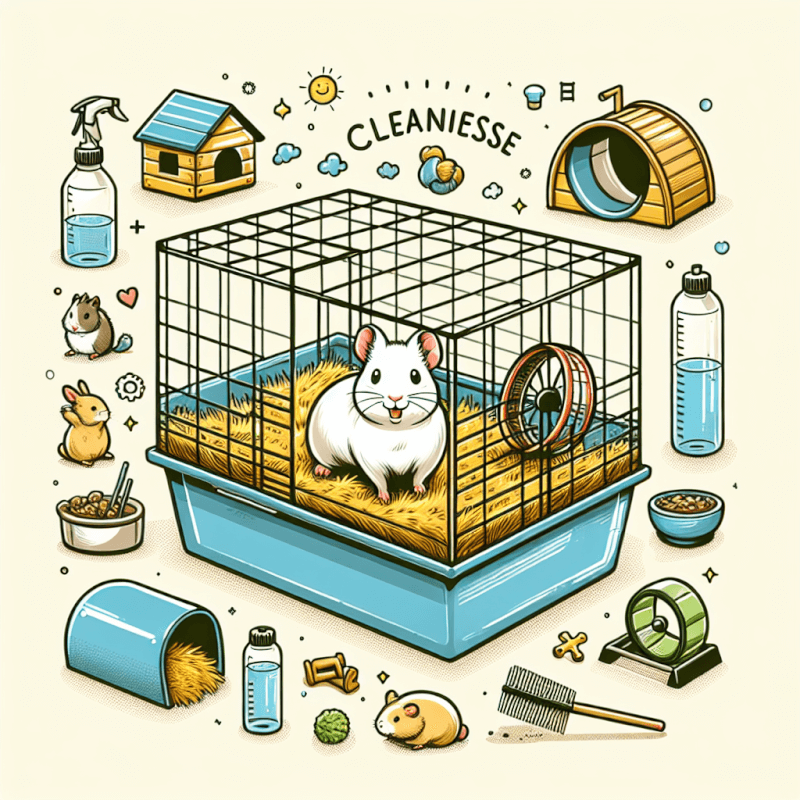Keeping your small animal’s cage clean is not only essential for maintaining their health and well-being, but it also ensures a pleasant environment for both you and your furry friend. But how often should you make time for this task? Regular cleaning is crucial, and in this article, we will provide you with some helpful tips and guidelines to help you determine the optimal cleaning frequency for your small animal’s cage. By following these recommendations, you can create a clean and comfortable habitat that your pet will surely appreciate.
Factors to Consider
Type of Animal
When determining how often to clean your small animal’s cage, it’s important to consider the type of animal you have. Different animals have different hygiene needs, and their waste and odor levels can vary. For example, a hamster may require less frequent cleanings than a guinea pig or rabbit.
Ready for Cat Trivia?
Test your knowledge about cats!

Size of Cage
The size of your small animal’s cage is another crucial factor to consider. A larger cage will generally accumulate waste at a slower rate, allowing for less frequent cleanings. On the other hand, a smaller cage may require more frequent cleaning to prevent waste buildup and maintain a clean environment.
Number of Animals in the Cage
If you have multiple animals living in the same cage, you may need to increase the frequency of your cleaning tasks. More animals mean more waste production and a higher likelihood of odors and cleanliness issues. Take into account the number of animals sharing the cage when establishing your cleaning routine.
Diet and Eating Habits
The diet and eating habits of your small animal can affect the cleanliness of their cage. Some animals, like rabbits or guinea pigs, have a diet rich in fresh fruits and vegetables, which can lead to more frequent waste production. Consider the impact of your pet’s diet on their cage cleanliness and adjust your cleaning routine accordingly.
Frequency of Waste Accumulation
Observing the rate at which waste accumulates in your small animal’s cage is crucial in determining how often you should clean it. Some animals produce waste more frequently than others, and the buildup of waste can lead to unpleasant odors and unsanitary conditions. Pay attention to how quickly waste accumulates and adjust your cleaning schedule accordingly.
Daily Cleaning Tasks
Removing Food Waste
Every day, you should remove any uneaten food from your small animal’s cage. Leaving food waste in the cage for an extended period can attract pests and lead to unpleasant smells. Take the time to check for any leftover food and promptly dispose of it.
Spot Cleaning
Performing daily spot cleaning is essential to maintain a clean and hygienic cage. Use a scoop or small shovel to remove any visible droppings or soiled bedding. This will help prevent waste buildup and keep the cage fresh.
Replacing Bedding
Regularly replacing the bedding in your small animal’s cage is essential for their comfort and hygiene. Bedding can become soiled and odorous over time, and it’s important to remove any wet or dirty bedding and replace it with fresh, clean bedding on a daily basis.
Checking Water Supply
Ensuring that your small animal has access to clean and fresh water is crucial for their health and well-being. Check the water supply in the cage daily, refilling it as needed and cleaning the water dispenser or bottle to prevent any bacterial growth.

Weekly Cleaning Tasks
Complete Cage Cleaning
On a weekly basis, it’s important to perform a thorough cleaning of your small animal’s cage. This involves removing all bedding, toys, and accessories from the cage and thoroughly cleaning the cage itself. Use a pet-safe cage cleaner or a mixture of mild soap and water to clean the cage thoroughly.
Washing Toys and Accessories
Small animal toys and accessories can quickly accumulate dirt, saliva, and waste. Once a week, take the time to clean your pet’s toys and accessories, ensuring they are free from any buildup or contamination. Use warm water and mild soap to clean them, rinsing them thoroughly before returning them to the cage.
Disinfecting Cage Surfaces
In addition to regular cleaning, it’s important to disinfect the cage surfaces to eliminate any bacteria or germs. Use a pet-safe disinfectant or a mixture of vinegar and water to wipe down the cage bars, floors, and any other surfaces. Remember to rinse the surfaces thoroughly to ensure no residue is left behind.
Inspecting Cage for Any Damage
While cleaning the cage, take the opportunity to inspect it for any signs of damage. Check for loose or broken bars, damaged flooring, or any other potential hazards that may need to be addressed. Ensuring the cage is in good condition will provide a safe and secure environment for your small animal.
Monthly Cleaning Tasks
Deep Cleaning Cage
Once a month, you should perform a deep cleaning of your small animal’s cage. This involves a more thorough cleaning and disinfection of the cage, including hard-to-reach areas. Take the time to disassemble any removable parts and clean them individually, ensuring all surfaces are properly cleaned and sanitized.
Scrubbing Cage Bars and Grates
Over time, cage bars and grates can accumulate dirt, grime, and even rust. Once a month, give the cage bars and grates a thorough scrubbing. Use a pet-safe scrub brush or toothbrush to remove any buildup, ensuring that the cage is clean and safe for your small animal.
Cleaning Filters and Ventilation Systems
If your small animal’s cage has a ventilation system or filter, make sure to clean it on a monthly basis. Follow the manufacturer’s instructions for cleaning and maintenance, ensuring that the filters are free from debris and the ventilation system is functioning properly.
Checking and Replacing Cage Accessories
Regularly inspect your small animal’s cage accessories, such as hideouts, climbing structures, and tunnels. Check for any signs of wear or damage and replace them as needed. Providing a safe and enriched environment for your small animal is essential for their well-being.

Signs That Your Cage Needs Cleaning
Strong Odors
One of the most obvious signs that your small animal’s cage needs cleaning is the presence of strong odors. If you notice unpleasant smells coming from the cage, it’s a clear indication that waste has accumulated and it’s time for a thorough cleaning.
Excessive Accumulation of Waste
If you find that waste is accumulating more quickly than usual or the cage looks excessively dirty, it’s a sign that your cleaning routine may need adjustment. Observe the waste accumulation patterns to ensure that you’re maintaining a clean and healthy environment for your small animal.
Mold or Mildew Growth
The presence of mold or mildew in your small animal’s cage is a serious concern. It can pose health risks to your pet and indicate that the cage is not being cleaned frequently enough. If you notice any mold or mildew growth, take immediate action to thoroughly clean and disinfect the cage.
Dirty or Cloudy Water
The water supply in your small animal’s cage should always be clean and clear. If the water appears dirty, cloudy, or has debris in it, it’s a sign that the cage needs cleaning. Replace the water and clean the water dispenser or bottle to prevent any potential health issues.
Unusual Behavior in Small Animals
Pay attention to any unusual behavior in your small animal. If they seem restless, agitated, or exhibit changes in eating or sleeping patterns, it could be a sign that their cage needs cleaning. Maintaining a clean and hygienic environment is crucial for your pet’s well-being.
Optimal Cleaning Frequency for Different Animals
Hamsters
Hamsters are relatively clean animals, and their cages typically require cleaning every 1-2 weeks. Spot cleaning should be done daily, and a thorough cage cleaning can be done on a weekly basis.
Gerbils
Gerbils also have low cleanliness needs. Their cages can be cleaned on a weekly basis, with daily spot cleaning to remove waste and soiled bedding.
Rats
Rats are generally cleaner animals and can have their cages cleaned every 1-2 weeks. Regular spot cleaning and daily removal of uneaten food are important for maintaining their cage cleanliness.
Guinea Pigs
Guinea pigs have higher hygiene needs and produce more waste. Their cages should be cleaned every 3-4 days, with regular spot cleaning and daily removal of uneaten food.
Rabbits
Rabbits are known for their strong odor and frequent waste production. Their cages should be cleaned every 2-3 days, with daily spot cleaning and removal of uneaten food.
Ferrets
Ferrets are relatively clean animals and can have their cages cleaned every 1-2 weeks. Spot cleaning should be done daily, and a thorough cage cleaning can be done on a weekly basis.
Chinchillas
Chinchillas have low cleanliness needs and can have their cages cleaned every 1-2 weeks. Regular spot cleaning and daily removal of uneaten food are important for maintaining their cage cleanliness.
Hedgehogs
Hedgehogs are generally clean animals and can have their cages cleaned every 1-2 weeks. Spot cleaning should be done daily, and a thorough cage cleaning can be done on a weekly basis.

Tips for Efficient Cage Cleaning
Use Safe and Appropriate Cleaning Products
Ensure that you are using pet-safe cleaning products when cleaning your small animal’s cage. Harsh chemicals can be harmful to your pet’s health. Read product labels and choose cleaning solutions specifically formulated for small animal cages.
Wear Protective Gloves
To protect yourself from potential bacteria or germs, it’s advisable to wear protective gloves when cleaning your small animal’s cage. This will prevent any skin irritation or potential infections.
Take the Animal Out of the Cage
When performing a thorough cage cleaning, it’s best to temporarily relocate your small animal to a safe and secure area. This will prevent them from getting in the way or accidentally ingesting any cleaning products. Ensure they have a comfortable and familiar environment while the cage is being cleaned.
Clean in a Well-Ventilated Area
Proper ventilation is important when cleaning your small animal’s cage. Choose a well-ventilated area or open windows to allow fresh air to circulate while you clean. This will prevent any strong odors or fumes from accumulating.
Establish a Cleaning Routine
Consistency is key when it comes to cage cleaning. Establish a cleaning routine that suits your schedule and stick to it. This will ensure that your small animal’s cage remains clean and hygienic on a regular basis.
Common Mistakes to Avoid
Using Harmful Chemicals
Using harsh or toxic chemicals can be harmful to your small animal’s health. Avoid using bleach, ammonia-based cleaners, or any products that contain harmful ingredients. Opt for pet-safe products specifically formulated for small animal cages.
Forgetting to Rinse Cleaning Products
After cleaning the cage, it’s important to thoroughly rinse any cleaning products or disinfectants from the surfaces. Residue left behind can be harmful if ingested by your small animal.
Neglecting to Dry the Cage Properly
After cleaning and rinsing the cage, make sure it is fully dry before putting bedding, toys, and accessories back in. Damp or wet conditions can lead to mold or mildew growth, which poses health risks to your small animal.
Not Cleaning Toys and Accessories
Neglecting to clean your small animal’s toys and accessories can result in the buildup of dirt, bacteria, and waste. Regularly clean and sanitize these items to ensure a clean and safe environment for your pet.

Conclusion
Regular and proper cage cleaning is essential for maintaining a clean and healthy environment for your small animal. By considering factors such as the type of animal, cage size, and waste accumulation rate, you can establish a cleaning routine that suits your pet’s needs.
Daily cleaning tasks, such as removing food waste and spot cleaning, should be done to prevent waste buildup. Weekly tasks, including complete cage cleaning and washing toys, will help maintain cleanliness. Monthly deep cleaning tasks and replacing cage accessories are also necessary to ensure a safe and hygienic living space.
Always be mindful of signs that indicate your cage needs cleaning, such as odors, excessive waste accumulation, mold or mildew growth, dirty water, or unusual behavior in your small animal. Adjust the frequency of cleaning based on the specific needs of your pet.
Remember to follow tips for efficient cage cleaning, such as using safe cleaning products, wearing protective gloves, and establishing a cleaning routine. Avoid common mistakes like using harmful chemicals, forgetting to rinse cleaning products, neglecting to dry the cage properly, and not cleaning toys and accessories.
By prioritizing regular and proper cage cleaning, you can provide a clean and healthy environment for your small animal, ensuring their well-being and happiness.


